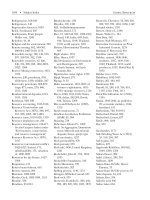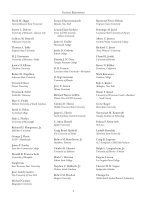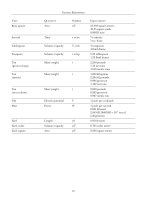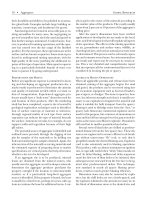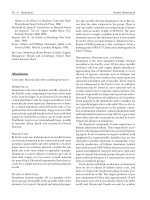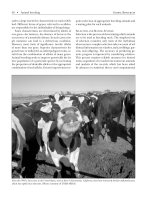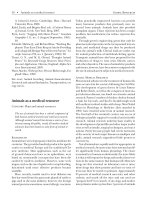Encyclopedia of Global Resources part 9 pptx
Bạn đang xem bản rút gọn của tài liệu. Xem và tải ngay bản đầy đủ của tài liệu tại đây (118.31 KB, 10 trang )
in Industrial America. Cambridge, Mass.: Harvard
University Press, 2008.
Kalof, Linda, and Brigitte Resl, eds. A Cultural History
of Animals. 6 vols. New York: Berg, 2007.
Pynn, Larry. “Logging with Horse Power.” Canadian
Geographic 111, no. 4 (August/September, 1991):
30.
Schmidt, Michael J., and Richard Ross. “Working Ele-
phants: They Earn Their Keep in Asia by Providing
an EcologicallyBenignWay to HarvestForests.” Sci-
entific American 274, no. 1 (January, 1996): 82.
Tiwari, G. N., and M. K. Ghosal. “Draught Animal
Power.” In Renewable Energy Resources: Basic Princi-
ples and Applications. Harrow, England: Alpha Sci-
ence International, 2005.
Watts, Martin. Working Oxen. Princes Risborough, En-
gland: Shire, 1999.
See also: Animal breeding; Animal domestication;
Livestock and animal husbandry; Transportation, en-
ergy use in.
Animals as a medical resource
Category: Plant and animal resources
The use of animals has been a critical component of
both human medical research and veterinary research.
Although animal research has become a source of con-
troversy among the public, nearly all modern medical
advances have been based on some form of animal re-
search.
Background
Animals have served purposes related to medicine for
centuries. They provided medical products for apoth-
ecaries in medieval Europe and for traditional Chi-
nese medicine. Most applications, such as the use
of ground rhinoceros horn as an aphrodisiac, were
based on nonscientific concepts that have been dis-
carded by modern medicine. However, some tech-
niques, such as the use of spiderweb to stop bleeding,
functioned until more effective products became
available.
More recently, insulin used to treat diabetes was
first harvested from the pancreatic glands of cattle or
pigs used in the meat industry; however, the foreign
animal proteins sometimes caused allergic reactions.
Today, genetically engineered bacteria can provide
many hormone products that previously were ex-
tracted from animals. Animals have also provided
transplant organs. Tissue rejection has been a major
problem, but medications can reduce rejection dra-
matically.
Through genetic engineering, genes that code for
pharmaceutical proteins can be incorporated into an-
imals, and medicinal drugs can then be produced
from the animal’s milk. Clinical trials are under way
for animal production of anti-blood-clotting agents.
Transgenic animals have also been proposed for the
production of drugs to treat cystic fibrosis, cancer,
and other disorders. The uses of animals for products
and tissues, however, have been minor compared with
the useofanimalsas testsubjectsin medical research.
Animal Medical Research
Phenomenal advances in the treatment of human dis-
eases occurred in the century following the Civil War.
The development of germ theory by Louis Pasteur
and Robert Koch, as well as the conquest of most ma-
jor infectious diseases, was based on extensive animal
research. Pasteur’s studies of chicken cholera formed
a basis for his work, and Koch’s breakthrough work
with anthrax involved studies with sheep. Most Nobel
Prizes in Physiology or Medicine (first awarded in
1901) have involved some form of animal research.
The first half of the twentieth century was an era of
widespread public support for medical and scientific
research. Animal research underlay basic studies in
the development of penicillin and other major antibi-
otics as well as insulin, surgical techniques, and vacci-
nations. Partly because people had recent memories
of the severity of such major diseases as smallpox and
polio, animal research engendered little protest or
controversy.
Not all animals are equally useful or appropriate in
medical research, because some have systems that dif-
fer significantly from human physiology. The closer
an animal is to humans evolutionarily, the more likely
it is that it will respond to drugsandmedical interven-
tions in the same manner that humans will. Most new
drugs are first screened on laboratory rats or mice;
those drugs that show promise and have no toxic ef-
fects may then be tested on primates. Approximately
95 percent of medical research uses mice and other
rodents, and nearly all the mice and rats used are
“purpose bred” for research. (Cats, dogs, and nonhu
-
man primates make up less than 1 percent of animals
50 • Animals as a medical resource Global Resources
used in research.) The protocols for Federal Drug
Administration approval of new drugs, as well as agri-
cultural and environmental standards, are based on
substantial animal testing to ensure the safety and
effectiveness of new medications.
Opposition and Controversy
Beginning in the late 1970’s, opposition to animal re-
search began to gain national attention. The books
Animal Liberation, byPeterSinger (1977), and The Case
for Animal Rights, by Tom Regan (1983), provided a
rationale to activists who questioned humans’ use of
other animals for medical research as well as for food,
fur, and educational uses. Organizations opposed to
some or all animal use in research range from radical
groups allegedly responsible for vandalism of research
laboratories (the Animal Liberation Front is among
the most radical groups) to milder animal protection-
ist organizations. Probably the best-known animal-
rights group is People for the Ethical Treatment of
Animals (PETA). Well-known defenders of animal re
-
search for medical science include the National Asso-
ciation for Biomedical Research (NABR), the
Incurably Ill for Animal Research, and Putting People
First.
Some anti-animal-research activists have con-
tended that all animal research can be replaced with
alternatives such as research involving tissue culture
and computer simulation. Activists also object to the
use of animals taken from animal shelters and com-
plain that current animal care regulations, particu-
larly under the Animal Welfare Act, are not rigorously
enforced by the U.S. Department of Agriculture.
The scientific community has defended animal re-
search for a number of reasons. Biological systems are
much more complex than any computer model de-
vised, so at present computer simulation has severe
limitations. Newdrugs rarelyrespond intissueculture
exactly as they do in a whole living organism. Re-
searchers point out that, although animals are taken
from shelters for research use, they constitute a mi-
nuscule amount of the dogs and cats that are eutha-
nized annually. By far, most of the animals used in
research and teaching are mice and rats. Research fa-
cilities are inspected by agencies such as the United
States Department of Agriculture’s Animal and Plant
Health Inspection Service, which enforces Animal
Welfare Act criteria. The Food and Drug Administra-
tion and the Environmental Protection Agency also
have laboratory practice regulations. The research
community also states that approximately 95 per-
cent of laboratory animals are never subjected to pain
and that the remaining animals are provided pain-
relieving drugs or anesthetics as soon as the study
permits.
John Richard Schrock
Further Reading
Birke, Lynda, Arnold Arluke, and Mike Michael. The
Sacrifice: How Scientific Experiments Transform Ani-
mals and People. West Lafayette, Ind.: Purdue Uni-
versity Press, 2007.
Carbone, Larry. What Animals Want: Expertise and Ad-
vocacy in Laboratory Animal Welfare Policy. New York:
Oxford University Press, 2004.
Haugen, David M., ed. Animal Experimentation.De-
troit: Greenhaven Press, 2007.
Monamy, Vaughan. Animal Experimentation: A Guide to
the Issues. 2d ed. New York: Cambridge University
Press, 2009.
Global Resources Animals as a medical resource • 51
This mouse was genetically engineered by researchers at the Univer
-
sity of California, Davis, to use in the study of breast cancer. (AP/
Wide World Photos)
National Research Council of the National Acad
-
emies. Science, Medicine, and Animals: A Circle of Dis-
covery. Washington, D.C.: National Research Coun-
cil, National Academies Press, 2004.
Paul, Ellen Frankel, and Jeffrey Paul, eds. Why Animal
Experimentation Matters: The UseofAnimalsin Medical
Research. Edison, N.J.: Transaction, 2001.
Regan, Tom. The Case for Animal Rights. 1983. Reprint.
Berkeley: University of California Press, 2004.
Rudacille, Deborah. The Scalpel and the Butterfly: The
Conflict Between Animal Research and Animal Protec-
tion. Berkeley:Universityof California Press, 2001.
Singer, Peter. Animal Liberation. 2d ed. New York: New
York Review of Books, 1990.
Verhetsel, Ernest. They Threaten Your Health: A Critique
of the Antivivisection/Animal Rights Movement.Tuc-
son, Ariz.: People for Ethical Animal Research,
1986.
Web Sites
Humane Society of the United States
Animal Testing
/>animal_testing
National Academies Press
Science, Medicine, and Animals
/>catalog.php?record_id=10733#toc
U.S. Food and Drug Administration
Animal Testing
/>See also: Animal breeding; Animal domestication;
Biotechnology; Livestock and animal husbandry;
Plants as a medical resource; Wildlife.
Antarctic treaties
Category: Laws and conventions
Date: Final draft presented on December 1, 1959;
became effective on June 23, 1961
The Antarctic Treaty of 1959, created and endorsed by
representatives of the twelve signatory nations and en-
dorsed by many other nations since, designates Antarc
-
tica as a demilitarized zone and bans commercial min
-
eral and oil exploration there until 2041, when the
treaty’s provisions will be reviewed and possibly al
-
tered. It also bans the disposal of radioactive waste in
the area.
Background
Exploration of Antarcticabeganearly in the twentieth
century when sailors hunting whales and seals pene-
trated the waters surrounding this forbidding conti-
nent. As early as 1940, seven countries—Argentina,
Australia, Chile, France, New Zealand, Norway, and
the United Kingdom—had laid claim to various parts
of Antarctica. Some such claims overlapped, increas-
ing the potential for conflict.
Antarctica is unique among Earth’s seven conti-
nents because it has no permanent residents and no
established government. Its harsh climate makes it
more suitable for scientists than for soldiers and en-
trepreneurs. During the International Geophysical
Year (IGY), which ran from July 1, 1957, until Decem-
ber 31, 1958, twelve nations built thirty-five scientific
research stations on the continent and fifteen on the
nearby Antarctic islands. As of 2009, there were sixty-
five research stations in Antarctica, many of which op-
erated only during the Antarctic summer, which runs
from mid-October until early March.
When the IGY ended, representatives from the
twelve nations involved in that project gathered in
Washington, D.C.,andproduced the AntarcticTreaty,
whose sixteen articles spelled out how the continent
would be devoted to scientific research. Representa-
tives of the twelve signatory nations presented the
treaty on December 1, 1959. It went into effect on
June 23, 1961.
Among other documents that compose the Antarc-
tic Treaty System are the Conservation of Antarctic
Fauna and Flora, the Convention for the Conserva-
tion of Antarctic Seals, and the Convention on the
Conservation of Antarctic Marine Living Resources.
The Antarctic Treaty was expanded in 1991, when
twenty-four countries signed the Madrid Protocol,
which banned commercial development, mining, and
exploration for oil on the continent for fifty years.
This provision will be reconsidered in 2041.
By 2010, forty-five nations,representing more than
80 percent of the world’s population, had endorsed
the Antarctic treaties, which are the most effective
such international treaties ever entered into by such a
broad spectrum of nations. Antarctica remains the
most peaceful of Earth’s seven continents, with repre
-
sentatives of nearly one hundred nations working co
-
52 • Antarctic treaties Global Resources
operatively on their scientific pursuits and sharing
their findings with their fellow scientists.
Provisions
The provisions of the Antarctic treaties were not ac-
cepted merely on the basis of a majority vote. They
were, instead, passed by consensus, which explains, at
least partially, their overwhelming success and broad
acceptance.
As the IGY neared its termination in 1958, consid-
erable concern existed that the sevennationsthathad
laid claim to parts of Antarctica would begin to have
disputes about their claims. It was these concerns that
led the U.S. State Department to inaugurate meetings
in Washington, D.C., with eleven other nations that
had vested interests in Antarctica.
Representatives of these nations metformore than
a year in an attempt to reach an accord that would
protect Antarctica from widespread incursions from a
host of nations. Through these meetings the Antarc-
tic Treaty was forged. It was signed on December 1,
1959, by representatives of the twelve nations that par-
ticipated in the IGY, after which it was ratified and
went into effect on June 23, 1961.
Perhaps the most important provision of the treaty
is its stipulation that all of the signatories agree to
abandon all territorial claims on this frozen conti-
nent. This provision alleviated the fear that the seven
nations that had previously laid claim to parts of Ant-
arctica, all of which were involved in drafting the
treaty, would exercise what they considered their pro-
prietary rights and could conceivably enter into dan-
gerous conflicts to protect such rights.
Once this caveat was overcome, the rest of the pro-
visions of the treaty fell into place. Cognizant of the
importance of keeping Antarctica a peaceful conti-
nent, the initial Antarctic Treaty banned all military
activity on the continent. It also forbade the testing of
weapons, nuclear testing, and the disposal of nuclear
waste on the continent. These provisions set aside 10
percent of the Earth’s surface as nuclear-free and de-
militarized zones.
Among the protective stipulations of the Antarctic
Treaty produced in 1959 is the prohibition of the im-
portation of soil into the continent. The fear is that
imported soil will carry with it unknown biohazards
such as fungi, bacteria, and insects that might pollute
the pristine atmosphere of Antarctica.
Openness is a major theme of the treaty’s provi
-
sions, which call for the free exchange of scientific in
-
formation among the disparate groups of scientists
who areinvolvedinpolar research. Scientistsfrom the
signatory nations covered by the treaty are expected
to share information with one another and to make
their research plans and scientific outcomes avail-
able. The provisions of the treaty permit personnel
from any of the research stations to visit and inspect
without prior notice any of the research facilities in
Antarctica.
Realizing that disputes arise inevitably in multina-
tional situations, those who drafted the treaty pro-
vided for conflict resolution. Efforts must be made to
settle disputes through arbitration or negotiation. If
such efforts fail, however, the problem is referred to
the International CourtofJusticeforaresolution that
is considered binding. Those who drafted the treaty
were conscious of the needto make it sufficientlyflex-
ible to dealwithnewissues or problems as theyarisein
rapidly changing contexts.
The official languages of the treaty are English,
French, Russian, and Spanish. The documents associ-
ated with the treaty are held by the government of the
United States, which is responsible for preserving
them and distributing them as required.
There are two levels of membership in the Antarc-
tic Treaty System, consultative and nonconsultative.
In order to be consultative members, nations must
maintain at least one research station in Antarctica.
Consultative members have voting rights that are not
available to nonconsultative members. In some in-
stances, consultative members close their research
stations, as India did its Dakshin Gangotri Station in
1981, but as long as they maintain one station—India
continues to maintain the Maitre Station as a perma-
nent facility—they retain consultative membership.
Since the enactment of the treaty, society has be-
come increasingly sensitive to environmental prob-
lems that received less attention in the 1960’s than
they did in the 1990’s and beyond. As a result of this
change in outlook, the Madrid Protocol was enacted
in 1991. It bans exploration for oil and other minerals
in Antarctica for fifty years. In 2041, this provision will
be revisited and possibly reconsidered.
Impact on Resource Use
Antarctica is a mineral-rich continent, but its harsh
climate and the thick ice sheets—some more than 3
kilometers deep—that cover it make the retrieval of
minerals expensive and hazardous. Many parts of the
continent never reach temperatures above freezing,
Global Resources Antarctic treaties • 53
and even those areas, such as the Antarctic Peninsula,
that have more moderate climates are too cold to sus-
tain much plant and animal life. Nevertheless, as min-
ing equipment becomes increasingly sophisticated,
the recoveryofoil and othermineralsfrom Antarctica
will undoubtedly become feasible.
The enactment of the Antarctic Treaty System has
been aimed at the preservation of a frozen wilderness
that has considerable potential as a source of natural
resources, although this potential remains underde-
veloped. Among the other natural resources of which
the continent boasts are stores of fresh water, esti-
mated to constitute 80 percent of the fresh water on
Earth. As water shortages become commonplace in
many parts of the developed world, means will be ex-
plored for transporting some of Antarctica’s abun-
dant water to water-starved regions.
Some Middle Eastern countries have already ex-
plored the possibilityofhaulinghugeicebergsinto ar-
eas that are parched and of using the fresh water in
them for irrigation and other purposes, including
drinking water. Most of the ice in icebergs is com-
posed of fresh water. Future additions to the Antarc-
tica Treaties will likely deal with the preservation and
transportation of huge masses of ice into the popu-
lated parts of the world that are much in need of
water. At the same time, future amendments may
need to address the consequences of global climate
change as well.
R. Baird Shuman
Further Reading
Bocknek, Jonathan. Antarctica: The Last Wilderness.
North Mankato, Minn.:SmartApple Media, 2004.
Currie, Stephen. Antarctica. New York: Lucent Books,
2004.
Karner,Julie.RoaldAmundsen:The Conquest of the South
Pole. New York: Crabtree, 2007.
Myers, Walter Dean. Antarctica: Journeys to the South
Pole. New York: Scholastic Press, 2004.
Rubin, Jeff. Antarctica. 4th ed. London: Lonely Planet,
2008.
Shackleton, Ernest. The Heart of the Antarctic: Being the
Story of the British Antarctic Expedition, 1907-1909.
New ed. London: Carroll and Graff, 1999.
Stonehouse, Bernard. North Pole, South Pole: A Guide to
the Ecology and Resources of the Arctic and Antarctic.
London: Prion, 1990.
See also: Climate and resources; Oil and natural gas
distribution; Oil and natural gas exploration; Ozone
layer and ozone hole debate; Population growth; Re-
sources as a source of international conflict.
Antimony
Category: Mineral and other nonliving resources
Where Found
While antimony does not often occur free in nature,
its ores are widely distributed. The antimony ore of
greatest commercial importance is stibnite (Sb
2
S
3
),
most of which is supplied by China, Germany, Peru,
and Japan, among other countries.
Primary Uses
Antimony is a strategic resource with many uses. It is a
key component inmanyalloys, and its compounds are
employed in the manufacture of such products as
ceramics and glass, batteries, paints and pigments,
chemicals, matches,explosives,fireworks, flame retar-
dants, and medicines.
Technical Definition
Antimony (abbreviated Sb), atomic number 51, is a
metalloid belonging to Group VA of the periodic ta-
ble of the elements. It has two naturally occurring iso-
topes and an average molecular weight of 121.75.
Pure antimony has rhombohedral crystals and is sil-
very blue-white in color. It is brittle, can be easily pow-
dered, and conducts heat and electricity poorly. Its
specific gravity is 6.69 at 20° Celsius; its melting point
is 630.5°Celsius,and its boilingpointis 1,380° Celsius.
Description, Distribution, and Forms
Antimony is a metalloid with a lithospheric concen-
tration of 0.2 gram per metric ton. When used in met-
allurgical combinations antimony forms hard, brittle
materials that melt at relatively low temperatures,
characteristics that make this element an important
component in many alloys.
The most economically important antimony ore is
antimony sulfide, or stibnite. In the United States the
element is usually obtained only as a by-product of
smelting the copper ore tetrahedrite, (Cu, Fe)
12
Sb
4
S
13
,
or other sulfide ores of base metals. While recycling
scrap metal and storage batteries was once a signifi
-
cant secondary source of antimony for the United
54 • Antimony Global Resources
States, the development of low-maintenance lead-
acid automobile batteries that use lead alloys with less
or no antimony has decreased this supply. In 2007, for
example, the United States consumed 9,590 metric
tons of antimony, and total world production was esti-
mated at 170,000 metric tons.
Antimony ores are widely distributed; China, Bo-
livia, South Africa, Russia, Tajikistan, and Australia
are the chief producers. China is believed to have the
world’s greatest reserves of the element; extensive de-
posits of stibnite are found in the southern province
of Hunan. Antimony-bearing rocks can be found in
soils, groundwater, and surface waters. Most antimony
deposits are associated with igneous activity and are
believed to have been precipitated from watery fluids
at relatively shallow depths and low temperatures.
Antimony is rarely found free in nature. Stibnite,
the predominant antimony ore, is a silvery gray sulfide
mineral that occurs in masses or prismatic crystals.
Frequently it is found in association with quartz and
economic minerals such as ores of mercury, tungsten,
tin, lead, copper, silver, andgold. Stibnite deposits are
often in the form of veins, seams, pockets, or lenses.
Antimony can enter groundwater and surface water
through the natural weathering of rockorthrough in-
dustrial pollution. It can cause disorders of the hu-
man respiratory and cardiovascular systems, skin, and
eyes, and it is a suspected cancer-causing agent. The
1974 Safe Drinking Water Act set the maximum allow-
able concentration for total antimony in drinking
water in the United States at 6 micrograms per liter.
History
Antimony has been used since biblical times as an in-
gredient in medicines and in kohl, an eye cosmetic
made up of powdered stibnite mixed with soot and
other materials. In Tello, Chaldea, a vase from ap-
proximately 4000 b.c.e. was found that had been cast
in elemental antimony; antimony was also reportedly
used by the early Egyptians to coat copper items. By
the sixteenth century, the element was recognized as
an alloyingredient that couldimprove thetoneof bell
metal; as a source of yellow pigment for painting
earthenware, enamels, and glass; and as an ulcer med-
icine. The earliest known description of the extrac-
tion of antimony from stibnite was written by Basilius
Valentinus around 1600. The increasing industrializa-
tion of the late nineteenth and early twentieth centu
-
ries was accompanied by a rapid rise in antimony
consumption. The need for ammunition, arms, and
flame-retardant items during World Wars I and II
further increased the demand for antimony. In the
1930’s, consumption of the element also rose with the
expansion of the automobile industry, which used
lead-antimony alloys in storage batteries.
Obtaining Antimony
Antimony ore is roasted with iron in a blast furnace;
the roasting produces antimony oxide, from which
the iron removes the oxygen to free the antimony. A
flux of sodium sulfate or sodium carbonate may be
used to prevent the loss of molten antimony through
evaporation. Complex ores, those with base metals
present, are treated by leaching and electrolysis.
Uses of Antimony
Antimony is an important element in many alloys. Bri-
tannia metal, an alloy of tin with antimony, copper,
and sometimes bismuth andzinc,resembles pewterin
appearance and is used in the manufacture of table-
ware. Antimony is sometimes added to pewter, an al-
loy composed largely of tin, to increase whiteness and
hardness. Babbitt metal, an antifriction alloy used in
bearings, is composed chiefly of tin, copper, and anti
-
mony. Type metal, named for its use in the manufac
-
Global Resources Antimony • 55
Source: Mineral
Commodity Summaries, 2009
Data from the U.S. Geological Survey,
.U.S.GovernmentPrinting
Office, 2009.
Flame
retardants
40%
Transportation
&batteries
22%
Chemicals
14%
Ceramics
&glass
11%
Other
13%
U.S. End Uses of Antimony
ture of printing type, is an alloy of lead with antimony,
tin, and sometimes copper; this alloy is also used in
metal parts for some musical instruments. Various al-
loys of antimony and lead are used in solder, starting-
lighting-ignition batteries (particularly plates, termi-
nals, and connectors), ammunition, communication
equipment, corrosion-resistant pumps and pipes, tank
linings, and roofing sheets.
Antimony is used as a decolorizing and refining
agent in television screens, fluorescent tubes, and op-
tical glass. Small amounts of the element are used in
some medicines. Antimony oxides serve as stabilizers
and flame retardants in plastics. They are also used to
make adhesives, rubber, textiles, paints, and other
combustibles flame resistant. Antimony sulfides are
employed as a component of fireworks and ammuni-
tion. Antimony compounds are used in the manufac-
ture of matches, explosives, vulcanized rubber, paints
and pigments, chemicals, semiconductors, batteries,
glass, and ceramics. Its military applications make an-
timony a strategic mineral.
Karen N. Kähler
Further Reading
Greenwood, N. N., and A. Earnshaw. “Arsenic, Anti-
mony, and Bismuth.” In Chemistry of the Elements.2d
ed. Boston: Butterworth-Heinemann, 1997.
Henderson, William. “The Group 15(Pnictogen)Ele-
ments: Nitrogen, Phosphorus, Arsenic, Antimony,
and Bismuth.” In Main Group Chemistry. Cam-
bridge, England:RoyalSociety of Chemistry, 2000.
Krebs, Robert E. The History and Use of Our Earth’s
Chemical Elements: A Reference Guide. Illustrations by
Rae Déjur. 2d ed. Westport, Conn.: Greenwood
Press, 2006.
Massey, A. G. “Group 15: The Pnictides—Nitrogen,
Phosphorus, Arsenic, Antimony, and Bismuth.” In
Main GroupChemistry. 2ded.New York:Wiley, 2000.
Web Sites
Natural Resources Canada
Canadian Minerals Yearbook, Mineral and Metal
Commodity Reviews
/>indu/cmy-amc/com-eng.htm
U.S. Geological Survey
Antimony: Statistics and Information
/>commodity/antimony
See also: Alloys; China; Germany; Hydrothermal
solutions and mineralization; Japan; Metals and met-
allurgy; Peru; Russia; South Africa; Strategic re-
sources.
Antiquities Act
Categories: Laws and conventions; government
and resources
Date: Signed into law June 8, 1906
By designating sites of historic importance for special
protection and preservation, the Act for the Preserva-
tion of American Antiquities, commonly known as the
Antiquities Act, pioneered the useofgovernment power
to defend both the environmental and cultural re-
sources of nations.
Background
As the population and economy of the United States
expanded throughout the late nineteenth and early
twentieth centuries, variousgroups becameconcerned
about the survival of important elements of American
culture and environment. Expanding urban centers
threatened wilderness areas, unrestrained tourism
damaged natural wonders, and archaeological sites
were vulnerable to unregulated pillaging.
The destruction of American Indian archaeologi-
cal sites by commercial relic hunters was a particular
concern, as archaeologists feared the loss or destruc-
tion of vital cultural artifacts. Their concerns reached
the desk of Iowa congressman John F. Lacy, chairman
of the House Committee on Public Lands (later the
Committee on Natural Resources). Concerned about
protecting properties in the public interest, Lacy in-
troduced the Antiquities Act as a means of preserving
properties of national importance even if the proper-
ties were in private hands. The act passed easily
through Congress, and became law when signed by
pro-conservation president Theodore Roosevelt.
The Antiquities Act represented a move toward
greater federal responsibility for preservation. Recog-
nizing that state and local governments lacked either
the will or the authority to protect sites of importance
to the national heritage, the U.S. federal government
used its power of eminent domain to placesites under
government care. This marked a major philosophical
shift away from government indifference to environ
-
56 • Antiquities Act Global Resources
mental issues and toward federal participation in
preservation efforts.
Provisions
The Antiquities Act authorized the president of the
United States to designate an area of historic, cul-
tural, or environmental importance a “national mon-
ument” under the ownership and stewardship of the
federal government, specifically the Department of
the Interior. If thefederalgovernmentdidnot already
own the property, the president could use the power
of eminent domain to acquire private property. The
act provided for the “proper care and management”
of the site to ensure its preservation but did allow ar-
chaeological excavation by qualified researchers un-
der the supervision of the government. In an attempt
to curb the pillaging of artifacts, the unauthorized re-
moval ofhistoricalartifactsbecame afederaloffense.
Impact on Resource Use
Although intended to protect archaeological sites,
the Antiquities Act also ensured the survival of a num-
ber of environmentally important areas. President
Roosevelt took a broad interpretation of the legisla-
tion and designated a wide range of sites for protec-
tion. Roosevelt designated Devils Tower in Wyoming
as the first national monument, followed by a number
of American Indiansitesin the Southwest. Since 1906,
the government has created more than one hundred
monuments in both rural areas, such as Muir Woods
in California, and urban areas, such as the Statue of
Liberty in New York. Between 2006 and 2008, Presi-
dent George W. Bush created the first underwater
monuments when he designated the Papah3naumo-
ku3kea Marine National Monument near Hawaii,
Marianas Trench Marine in the central Pacific, and
the Pacific Remote Islands and Rose Atoll Marines in
the U.S owned islands of the South Pacific.
Steven J. Ramold
See also: National Park Service; National Parks Act,
Canadian; National parks and nature reserves; Re-
source Conservation and Recovery Act; Takings law
and eminent domain.
Appliances. See Buildings and
appliances, energy-efficient
Aquifers
Category: Geological processes and formations
An aquifer is a body of earth material that can store
and transmit economically significant amounts of
water. The earth material can be in either consolidated
or unconsolidated form as long as it has sufficient
permeability for the movement of water. In terms of
groundwater occurrence, all the rocks found on and
below the Earth’s surface are associated with either
aquifers or confining beds.
Background
An aquifer is a rock unit that is permeable enough to
yield water in usable amounts to a well or a spring. In
geologic usage, the term “rock” includes unconsoli-
dated sediments such as sand, silt, and clay, as well as
what is commonly considered to be rock. A confining
bed is a rock unit that has such low hydraulic conduc-
tivity (poor permeability) that it restricts or severely
impedes theflowofgroundwater into oroutofnearby
aquifers.
Unconfined and Artesian Aquifers
There aretwomajor types ofgroundwater occurrence
in aquifers. The first type pertains to those aquifers
that are only partially filled with water. In those cases,
the upper surface (or water table) of the saturated
zone can rise or decline in response to variations in
precipitation, evaporation, and pumping from wells.
The water in theseaquifersisclassifiedas unconfined,
and such aquifers are called unconfined, or water-
table, aquifers.
The second type occurs whenwatercompletelyfills
an aquifer that is overlain by a confining bed. In this
case, the water in such an aquifer is classified as con-
fined and the aquifers are called confined, or arte-
sian, aquifers. In some fractured rock formations,
such as thosethatoccurin the west-central portions of
New Jersey and eastern Pennsylvania, local geologic
conditions result in semiconfined aquifers that, as
one might expect, have hydrogeologic characteristics
of both unconfined and confined aquifers.
Wells that are drilled in unconfined, water-table
aquifers are simply called water-table wells. The water
level in these unconfined wells indicates the depth be
-
low the surface of the water table, which is the top of
the saturated zone. Wells that are drilled into con
-
Global Resources Aquifers • 57
fined aquifersare calledartesianwells. The water level
in an artesian well is generally located at a height
above the top of the confined aquifer but not neces-
sarily above the land surface. Flowing artesian wells
occur when the water level in an artesian well stands
above thelandsurface. Thewaterlevel in tightly cased
wells in unconfined or artesian aquifers is called the
potentiometric surface of the aquifer.
Aquifer Permeability
Water flows (very slowly) in aquifers from recharge ar-
eas in interstream areas at higher elevations to dis-
58 • Aquifers Global Resources
Source: Basic Ground-Water Hydrology
Note:
Ralph C. Heath, , U.S. Geological Survey Water-Supply Paper 2220, 1983.
Rocks vary tremendously in their ability to conduct water. The meters-per-day scale is logarithmic: Each increment to the
right and left of 1 indicates a change by a power of 10: to the right, 10 meters, 1,000 meters, and 100,000 meters; to the left,
0.1 meter, 0.01 meter, 0.001 meter, and so on.
10
–7
10
–6
10
–5
10
–4
10
–3
10
–2
10
–1
11010
2
10
3
10
4
10
–8
Meters per Day
GRAVELGLACIAL TILL
CLEAN SAND
Fine Coarse
SILTY SAND
SILT, LOESS
CLAY
CARBONATE ROCKS
Fractured
Cavernous
SHALE
Unfractured Fractured
SANDSTONE
Fractured Semiconsolidated
BASALT
Unfractured Fractured Lava flow
IGNEOUS AND METAMORPHIC ROCKS
Unfractured Fractured
10
–7
10
–6
10
–5
10
–4
10
–3
10
–2
10
–1
11010
2
10
3
10
4
10
–8
Meters per Day
Hydraulic Conductivity of Select Rocks and Materials
charge areas along streams and adjacent floodplains
at lower elevations. Thus, aquifers function as “pipe-
lines” filled with various types of earth material.
Darcy’s law governing groundwater flow was devel-
oped by Henry Darcy, a French engineer, in 1856. In
brief, Darcy’s law states that the amount of water mov-
ing through an aquifer per unit of time is dependent
on the hydraulic conductivity (or permeability)ofthe
aquifer, the cross-sectional area that is at a right angle
to the direction of flow, and the hydraulic gradient.
The hydraulic conductivity depends upon the size
and interconnectedness of the pores and fractures in
an aquifer. It ranges through an astonishing twelveor-
ders of magnitude. There are few other physical pa-
rameters that have such a wide range ofvalues. For ex-
ample, the hydraulic conductivity ranges from an
extremely low 10
−7
and 10
−8
meters per day in
unfractured igneous rock such as diabase and basalt
to as much as 10
3
and 10
4
meters per day in cavernous
limestone and coarse gravel. Typical low-permeability
earth materials include unfractured shale, clay, and
glacial till. High-permeability earth materials include
lava flows and coarse sand.
In addition to this wide range of values, hydraulic
conductivity varies widely in place and in direction-
ality within the same aquifer. Aquifers are isotropic if
the hydraulic conductivity is about the same in all di-
rections, and anisotropic if it is different in different
directions. Asaresult of all ofthesefactors, groundwa-
ter yield is extremely variable both within the same
aquifer and from one aquifer to another when they
are composed of different rocks.
Aquifer Tests
In order to determine the groundwater yield and
contaminant transport characteristics of an aquifer,
it is necessary to obtain sufficient geologic and hy-
drologic information. One of the most important
hydrologic investigations insuchastudy is the analysis
of the change over time of the water levels in an aqui-
fer as a consequence of well pumpage. This type of
study is called an aquifer test and usually involves
pumping a well at a constant rate for several hours to
several days while changes in the water levels of one or
more observation wells located at different distances
from the pumped well are measured. The test pro-
vides invaluable information about the ability of an
aquifer to yield sufficient water under the stress of
constant pumping.
Robert M. Hordon
Further Reading
Appelo, C. A. J., and D. Postma. Geochemistry, Ground-
water, and Pollution. 2d ed. New York: Balkema,
2005.
Fetter, C. W. Applied Hydrogeology. 4th ed. Upper Sad-
dle River, N.J.: Prentice Hall, 2001.
Price, Michael. Introducing Groundwater. 2d ed. New
York: Chapman & Hall, 1996.
Todd, David Keith, and Larry W. Mays. Groundwater
Hydrology. 3d ed. Hoboken, N.J.: Wiley, 2005.
Younger, Paul L. Groundwater in theEnvironment:AnIn-
troduction. Malden, Mass.: Blackwell, 2007.
Zektser, Igor S., and Lorne G. Everett, eds. Ground
Water Resources of the World and Their Use. Paris:
UNESCO, 2004. Reprint. Westerville, Ohio: Na-
tional Ground Water Association Press, 2006.
Web Sites
Natural Resources Canada
Groundwater
/>freshwater/distribution/groundwater/1
U.S. Geological Survey
Aquifer Basics
/>See also: Environmental engineering; Glaciation;
Groundwater; Hydrology and the hydrologic cycle;
Land-use planning; U.S. Geological Survey; Water
pollution and water pollution control; Water supply
systems.
Argentina
Categories: Countries; government and resources
Argentina’s greatest primary natural resource isitsag-
ricultural land. Owing to its size, Argentina has a va-
riety of climates and soils in which to grow crops and
raise livestock. As a result, the country is a top-ten ex-
porter of a variety of crop and meat products. More-
over, a complex geology endows Argentina with depos-
its of petroleum, natural gas, copper, gold, and other
minerals that make the country a significant exporter
of these materials to its neighbors and other countries
around the globe.
Global Resources Argentina • 59
